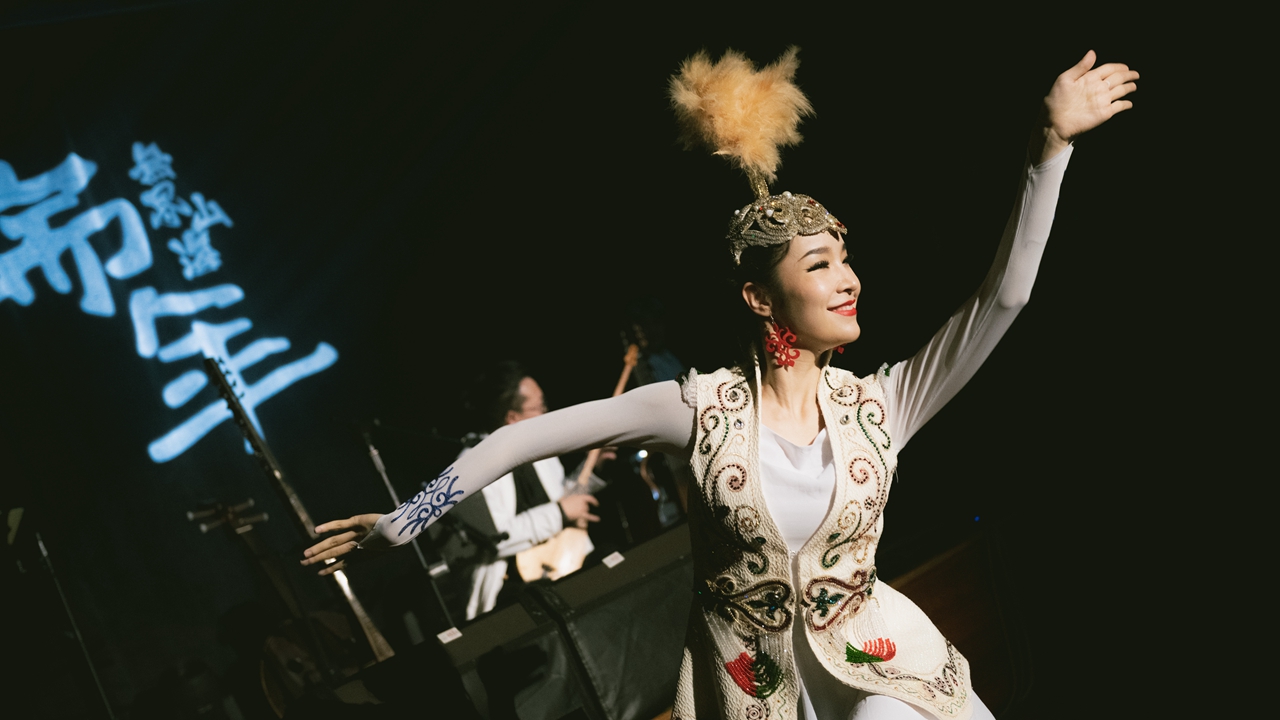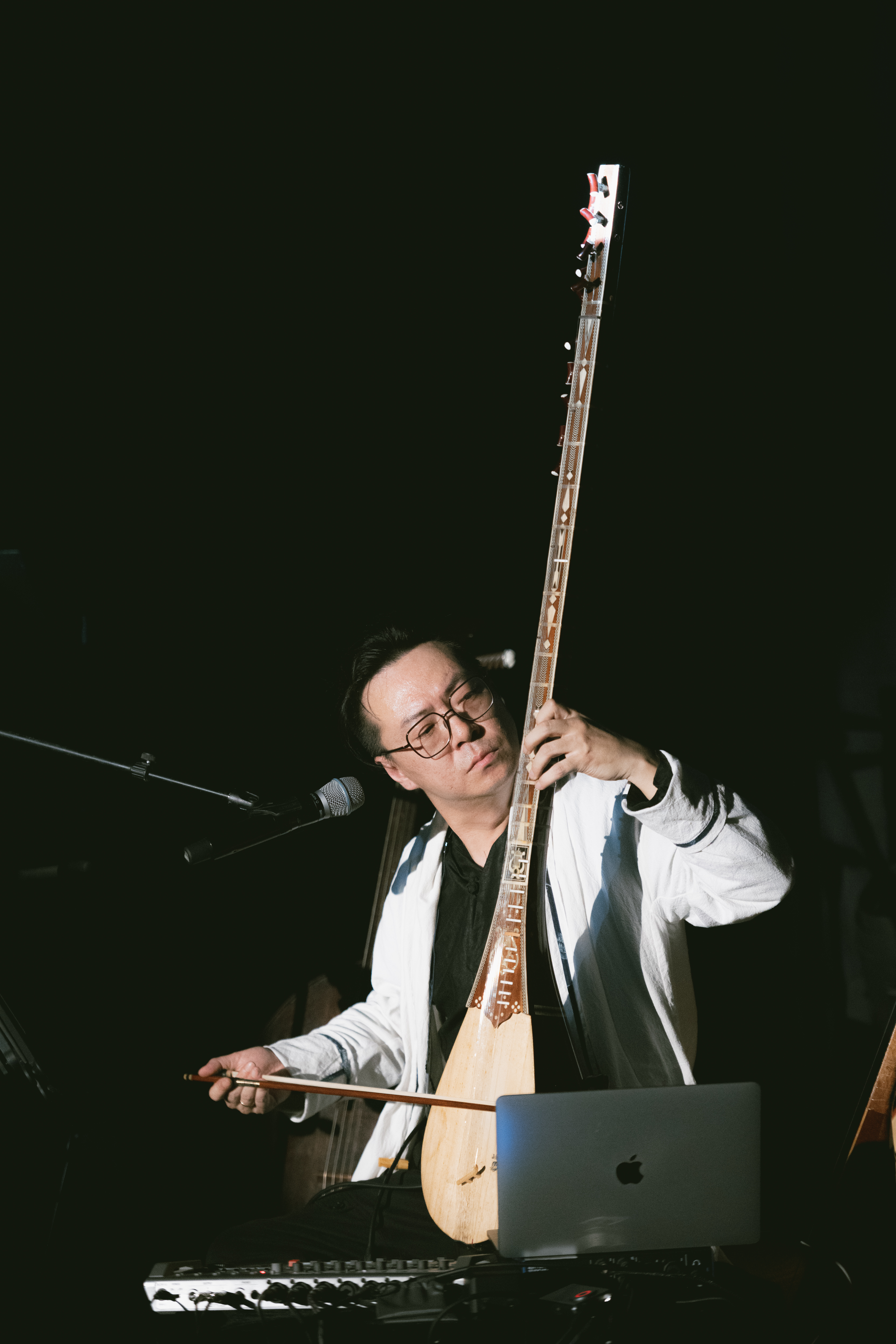Crossover band releases sophomore album
At an intimate concert attended by a little more than 200 people in a fully packed hall on the campus of Southern University of Science and Technology (SUSTech) in Nanshan District on Thursday, the Pilgrims Crossover Band performed tracks from their sophomore album “Rui Nian” (“Auspicious Year”). Many in the audience were fans of the group who seldom miss their shows; passionate applause erupted in the hall after each piece.

Gaohar gives a guest performance of a Kazak dance in the concert on SUSTech campus Thursday.
The album, which consists of eight tracks, was released March 30 by Starsing, a Guangzhou-based label, and as a digital album on the NetEase music site.
First-time listeners of their music will be immediately reminded of Yanni and his New Age music, as the music of the Pilgrims also incorporates soothing natural sounds such as birds chirping, creeks burbling, wind, and ocean waves. However, that is mostly where the similarities end.

Gu Bo performs on the satar in the concert. Photos courtesy of the organizers
“What makes our music stand out is a focus on Chinese instruments and traditional Chinese aesthetics,” said Gu Bo, the strings musician and soul of the band, which consists of eight versatile musicians. By writing original pieces, Gu hopes to give full display of the unique expressiveness of Chinese instruments, adding percussion and other sounds to make their music more readily embraced by modern audiences.
In addition to the namesake piece “Rui Nian,” which evokes joyful emotions and expresses wishes for a good year after the pandemic, the other tracks respectively depict the soothing or spectacular sceneries of spring in areas south of the Yangtze River, summer by the Yellow River, autumn on the prairies, winter in snow-clad Beijing, as well as the familiar landscape of Shenzhen and the natural beauty of Gu’s hometown Xinjiang.
What immediately differentiates the Pilgrims from other crossover bands is their choice of unique instruments. While the combination of guitar, bass, violin, and percussion are common, the group also employs the shakuhachi, yangqin, dombra, ruan, and satar, a bowed string instrument with a long neck used by Uygur ethnic musicians.
Gu, who began playing the guitar at 6 instructed by his father, was born and raised in Xinjiang. He was named one of the Top 10 Guitarists in China in 2013 and serves as a guest professor at the Jinzhong Conservatory of Music, Shenzhen University.
“Although I am not of Uygur origin, I grew up listening to their music,” he said. “It’s very difficult to carry on those traditions, as playing a niche instrument doesn’t help pay the bills. Two old masters I knew who could play the satar really well died last year, whose skills could be hardly matched by their disciples. Nor are the young musicians willing to invest the same amount of time and energy to practice as their masters did.”
While the shakuhachi, with the Chinese name “chi ba” depicting its length, is almost as old as guqin, it’s far less popular than the xiao, a Chinese end-blown bamboo flute with a similar structure. “The xiao is easier to play and more pleasant to the untrained ear with its mellow and melancholy tone,” he explained. “While Japanese musicians have written beautiful pieces for the shakuhachi, it is nearly extinct in China, its native country.”
During a tour that brought him to Peru and Chile in 2019, Gu was impressed by the enthusiasm of local artists about their own instruments, like the charango. “They write new stuff for the old instrument to keep it alive and relevant to modern life. I decided that I want to do the same with our traditions.”
Having limited training in composition wasn’t a deterrent for Gu. “When you’ve played instruments for long enough and when you’ve heard a huge number of works by others, the biggest issue is not how but do you dare,” he reckoned.
“Certainly, I understand the theories, and I always enjoy live performances. But the idea of writing my own had often been intimidating until after that tour to Peru. I really wanted to write something for the shakuhachi and guitar together.”
His first piece, “Wind in the Mangroves,” was written after he spent quite a while waiting by the seacoast in Bao’an District one day for a friend. “The sunset was stunning, the breeze was refreshing, and the ripples danced in the sunshine,” he recalled.
The band’s debut album, “Amir,” released in 2021, received rave reviews from critics and won them a small but loyal following.
“That album basically headlines classical guitar, with other instruments chiming in to create soothing and melodious tunes; while this new album is more versatile and colorful,” he said.
With pandemic-era restrictions lifted, Gu is looking forward to a good year, with 60 to 80 live shows ahead.
During Thursday’s concert, the band pledged to donate 10% of their sales revenue from the album to a charity foundation that helps treat those in Xinjiang who have limb disabilities.
The concert was a highlight of SUSTech’s Traditional Culture Month, which, according to the school’s senior official Li Fengliang, aims to nurture a passion for music and Chinese traditions in students.